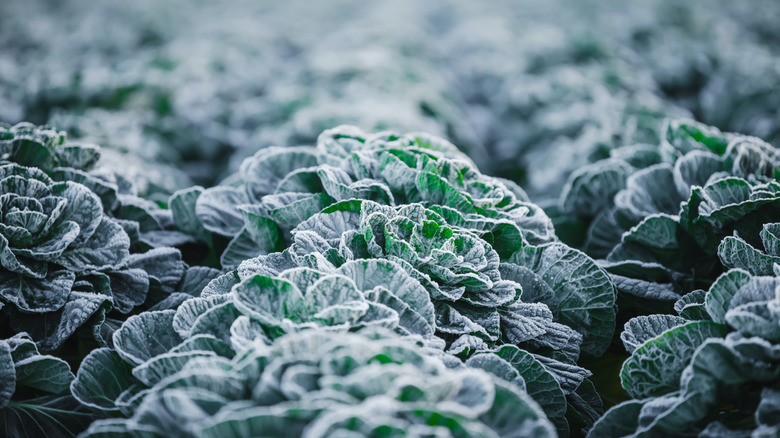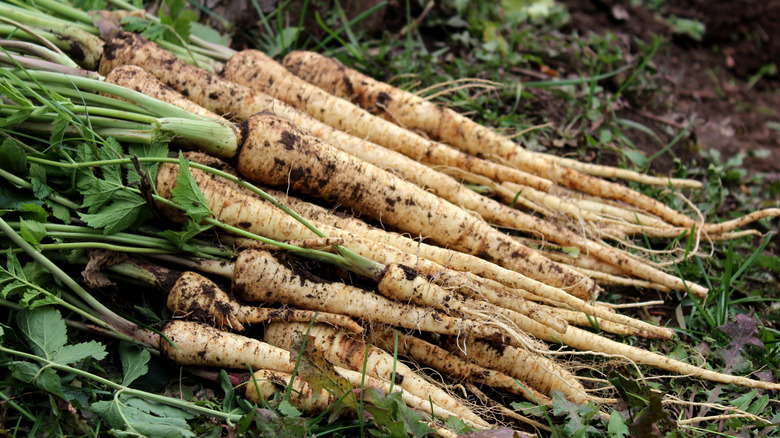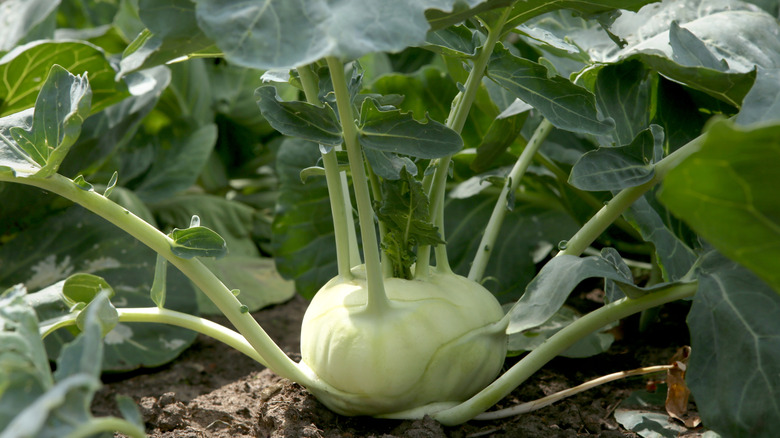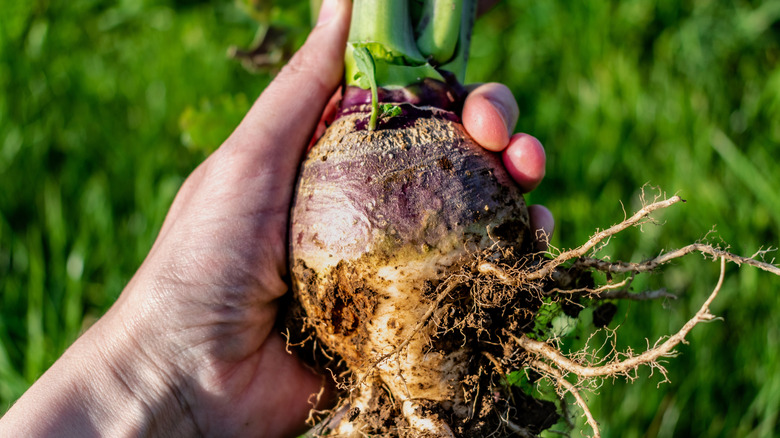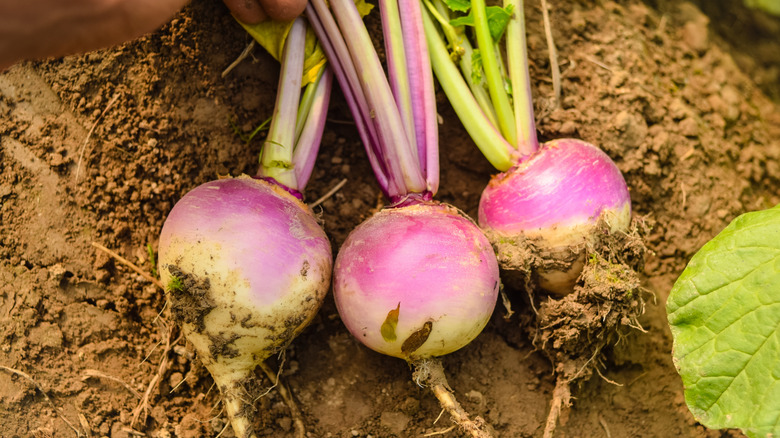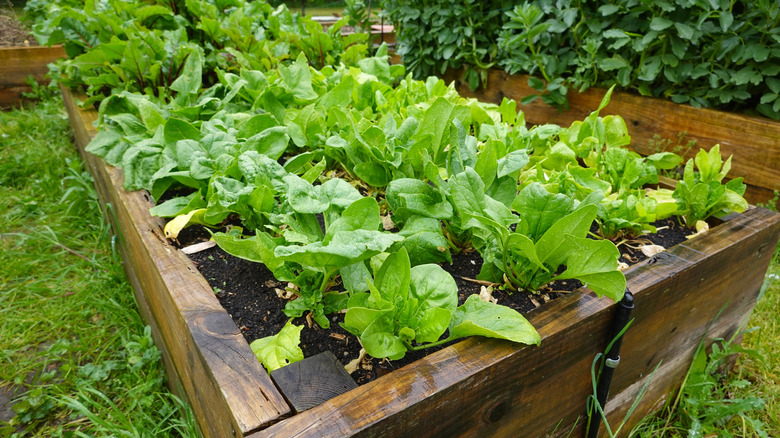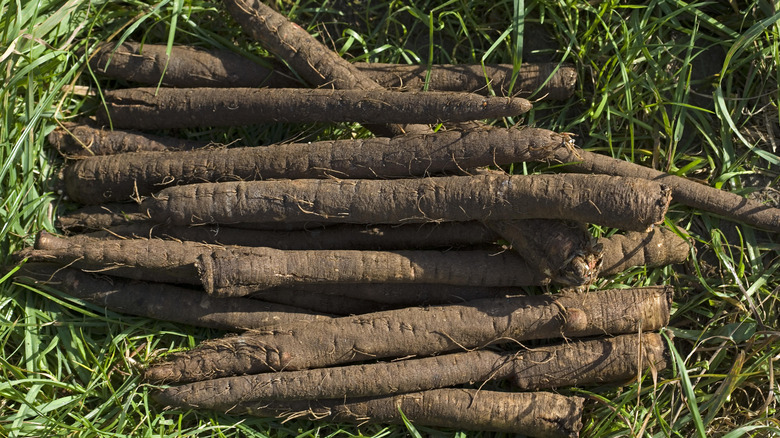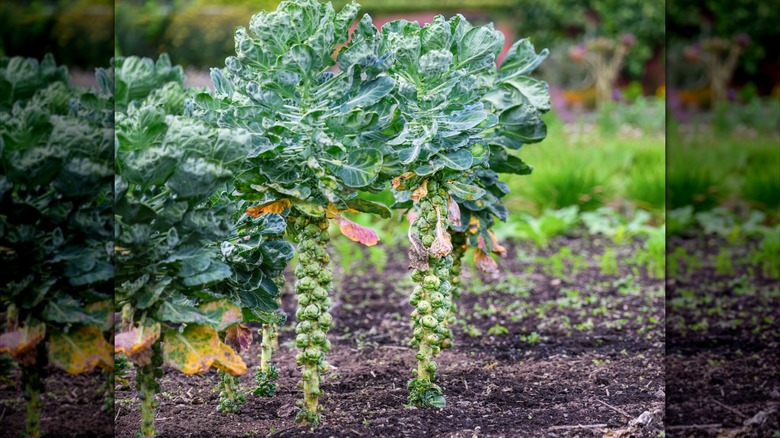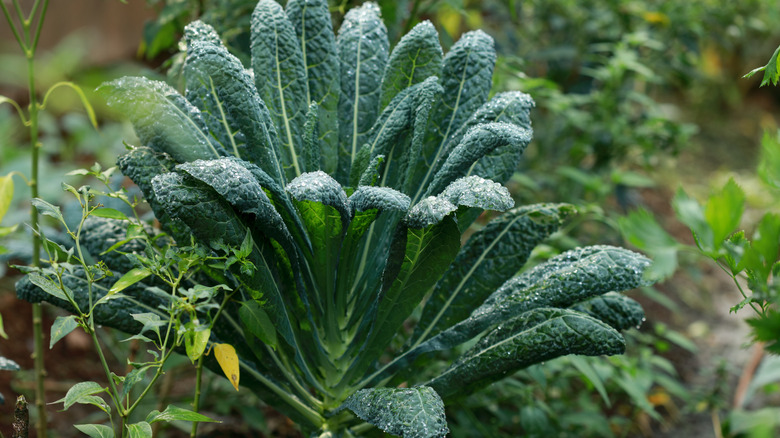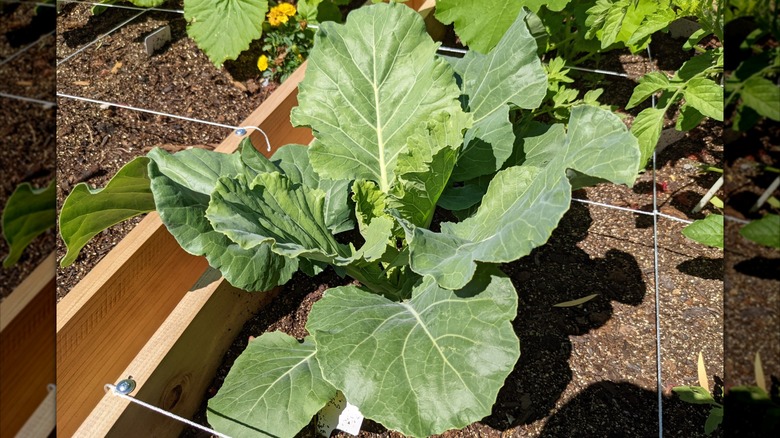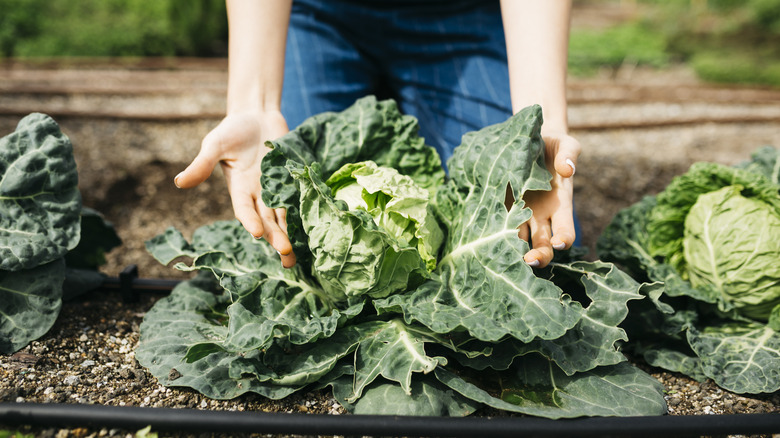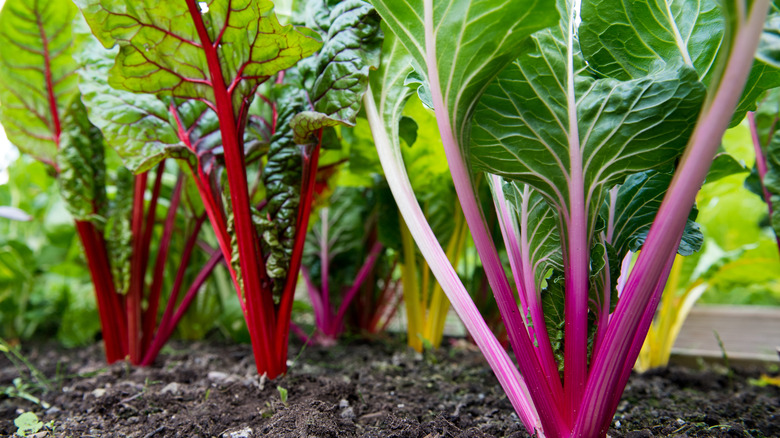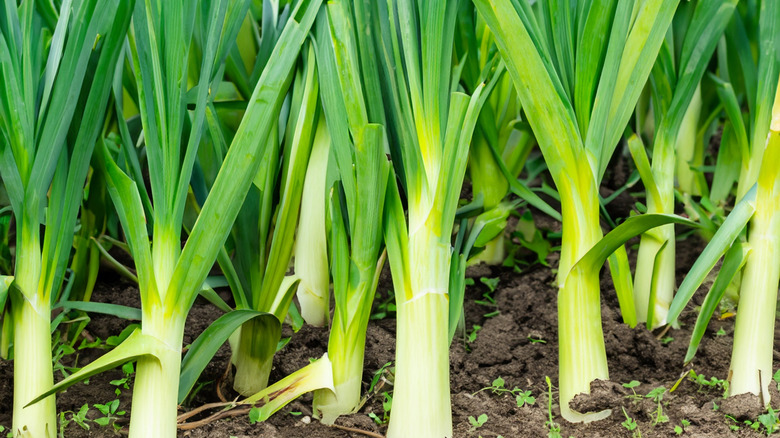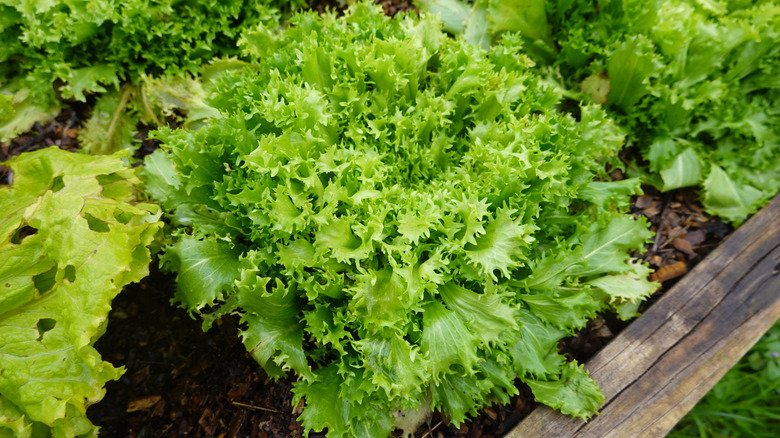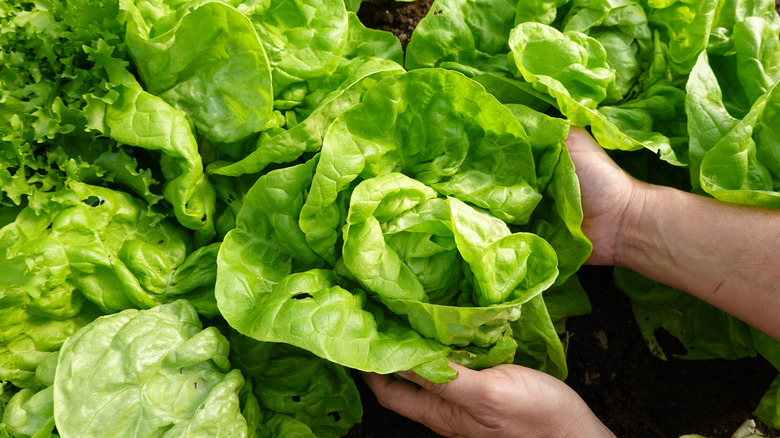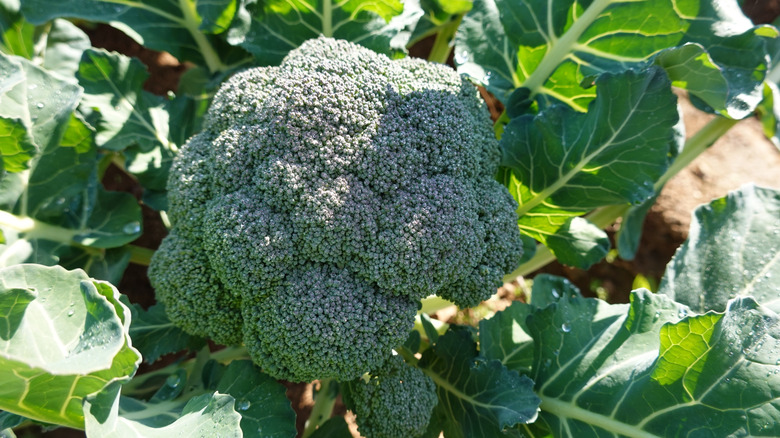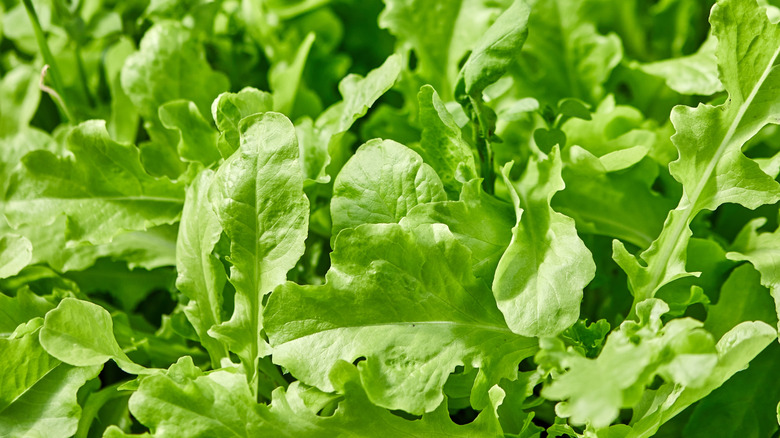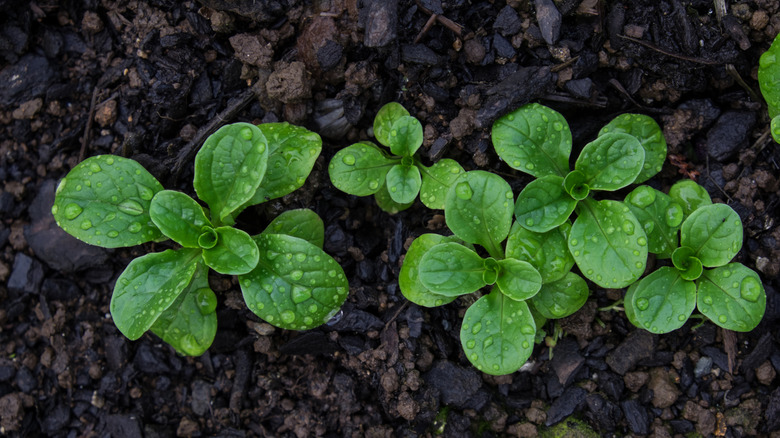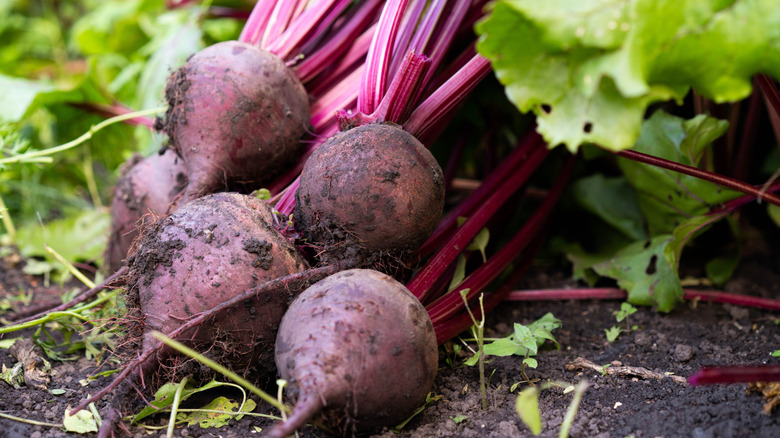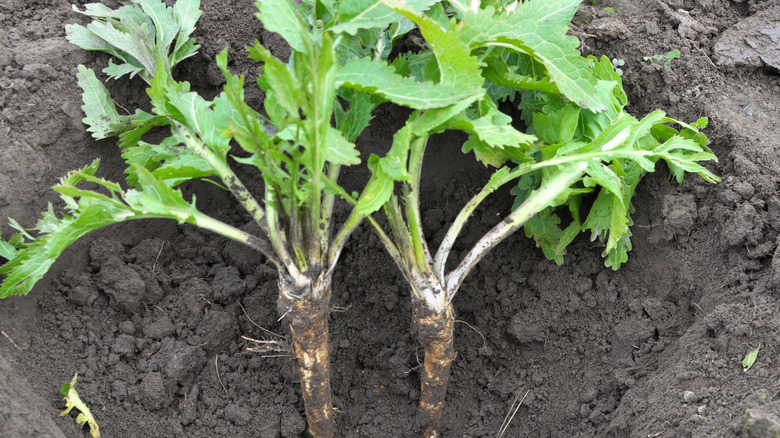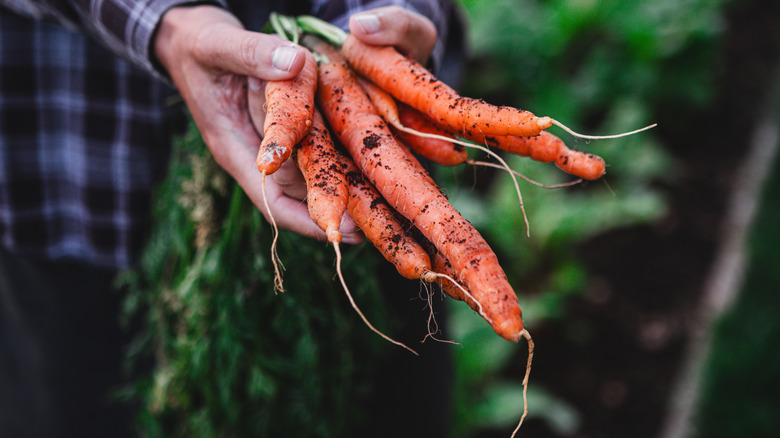20 Vegetables You Should Wait To Harvest After A Big Frost
When you maintain a vegetable garden, keeping track of frost dates becomes second nature. After all, you wouldn't want to lose your crop from a sudden freeze after leveling so much love, care, and attention (side-eying those tomatoes). However, not all vegetables must be picked before cold weather. Unless the concerned plant hails from warm regions, you could likely push its pickings to well past a few frosts — and be glad you did. Some garden veggies taste so much sweeter in the winter, especially the vegetables that grow underground, like parsnips and rutabagas, and cole crops, like Brussels sprouts and cabbage. That's because they create more sugars when the mercury dips below 40 degrees Fahrenheit. Since sugar water has a lower freezing point than regular water, these plants can survive freezing temperatures while building a richer taste and texture profile. That said, removing root vegetables from the soil before it freezes over completely is a good idea.
The cold endurance of these frost-hardy crops varies. For example, horseradish can survive inside the ground all winter long with mulch, while Brussels sprouts and salsify only endure moderate frosts. Likewise, leafy greens like kale and chards benefit from frost exposure (usually tolerating temperature drops to 28 degrees Fahrenheit) and can be harvested toward the end of the year in temperate climates. In light of such variations, it makes sense to know which vegetables can — or should — be harvested after a major frost so that you can enjoy them more at mealtime. Read on to learn about your options.
Parsnips
You might dislike parsnips for taking their sweet time (upwards of 100 days after sowing) to mature. But they'll be worth the wait if you expose them to near-freezing temperatures for around four weeks before harvesting. That way, the parsnips can convert their starches into sugars, gaining a sweet and nutty taste. Parsnip's roots reach 12 inches in length, so water them a day before and use a garden fork to loosen the soil to avoid breaking them while harvesting. You can even overwinter parsnips in the garden by mulching over their crowns, just harvest them before new growth appears.
Kohlrabi
Like cabbage and cauliflower, kohlrabi is considered a "cole crop," and it displays a fair tolerance for freezing temperatures. You should harvest fall-planted kohlrabi about two weeks after the first frost, since the temperature drop sweetens the vegetable's flavor. However, in states with milder climates, like Oregon, it can stay in the garden right up to Christmas. If you plant giant kohlrabis, you'll be able to overwinter them successfully with straw mulch even if local temperatures dip below 15 degrees Fahrenheit.
Rutabaga
Yellow-bodied rutabagas (also known as "Swedish turnips") prefer to be left alone to brave through a few light frosts before you pick them. The cooler temperatures encourage the starch-to-sugar conversion, improving their taste and texture, and explaining their popularity in northern states. Since rutabagas taste better when their roots have grown over 4 inches wide, keeping them growing even longer makes sense. In fact, as long as the ground isn't frozen solid, they can survive in the soil well into late fall as long as you protect their surface-dwelling roots with mulch.
Turnips
Think store-bought turnips taste better in the winter? That's because they do. Fall-planted turnips are often superior to their spring- and summer-planted counterparts, as they grow sweeter in tandem with the cooling weather. Light frosts aren't a problem, so you have ample time to harvest leaves for salads through early winter until you're ready to harvest their roots. However, be sure to cover your crop with straw mulch, or it may suffer cold injury, especially when the temperatures drop and remain below 30 degrees Fahrenheit.
Spinach
Spinach is another tasty, cold-hardy vegetable to plant in your fall garden — in some areas it can be directly seeded in the ground even in November. Spinach tends to grow sweeter when it's exposed to cool temperatures, allowing for harvesting after a big frost, sometimes right through December. In mild winters of southern states, spinach is a suitable candidate for winter gardening. All the seedlings need is a thick layer of mulch to survive the cold and get ready for picking in early spring. Hybrid varieties like 'Oriental Giant' provide ripe leaves throughout the winter.
Salsify
If you've transitioned to veganism but ache for some seafood now and then, chances are you've heard about or even grown the oyster plant, or salsify, in your garden. Fortunately, it too is cold hardy, with roots that turn increasingly sweeter after experiencing several hard frosts. Salsify is often interplanted with parsnips and harvested side-by-side all through the winter — sometimes right into early spring. Naturally, it's best to cover their roots with mulch to stave off winter injury. 'Mammoth Sandwich Island' variety is excellent for post-frost harvesting, although you must wait four months for its yields.
Brussels sprouts
Brussels sprouts are another vegetable that's best to harvest after a few frosts. First, their flavor improves after extended exposure to cooler temperatures. Second, since Brussels sprouts are grown for their swollen leaf buds, it's ideal to let their stems grow to around 3 feet — this height helps increase the crop yield and makes late fall or early winter the perfect time for harvest. In southern states, they can be harvested all winter long, as they easily withstand temperature drops to 20 degrees Fahrenheit.
Kale
Another salad green that becomes sweeter and more delicious after exposure to a couple of frosts is kale. However, protect it with a row cover or mulch below 15 degrees Fahrenheit. Varieties like 'Winterbor,' 'Lacinto,' and 'Vates' are especially frost-hardy and can be harvested until the ground freezes for good during the winter. It helps to plant them early, around late summer, as plants tend to be more cold-tolerant when they're closer to maturity. Add two weeks to maturity, then subtract from the first frost date to establish the ideal planting time.
Collard greens
Think kale is the unbeaten superstar of your winter garden? Collard greens would love a metaphorical chat. They're hardier than most, surviving freezing temperatures down to 0 degrees Fahrenheit, making them a good fit for early winter harvesting in northern climates. Down south, they can be harvested throughout the year, though their flavor is far superior when leaves are picked after frost. Some cold-tolerant varieties, such as the bolt-resistant Champion collards, can even overwinter in your garden. The 'Blue Max' variety is the hardiest of them all and keeps on producing, regardless of snow cover.
Cabbage
Certain early-maturing cabbage cultivars, such as 'Early Thunder' and 'Quick Start,' can be gathered after frosts. This timing is subject to getting them planted at least 50 days ahead of the expected maturity, so that they can form their heads before cold weather arrives. Harvest them along with their roots and store them root-up in the garden in a heavily mulched trench. Otherwise, opt for the hardier savoy varieties, like 'January King,' 'Marabel,' and 'Brunswick.' These can successfully overwinter in gardens through zone 6 without protection.
Chards
Although multicolored chards are often used as ornamental plants, you must stick with the relatively staid white or green varieties, such as 'Fordhook Giant' or 'Verde de Taglio,' if you want the sweeter, post-frost harvest. Timely planting is key, as young plants can sustain light damage in temperatures below 32 degrees Fahrenheit. However, mature plants can tolerate declines to mid-20s, extending the harvesting season. In harsher climates, protect the plants with cold frames or low tunnels after the first few frosts. The younger leaves resemble spinach, so you can eat them raw. The older ones are tougher and should be cooked.
Leeks
Leeks withstand temperatures down to 20 degrees Fahrenheit and become sweeter after a frost. This allows harvesting right through the winter in zones 7 and higher. However, to ensure your leek crops take no damage from sub-freezing temperatures, mulch them beforehand in the fall with leaves or straw and mound the soil. Leeks exhibit varying cold tolerance across varieties and locations. For instance, blue-green varieties, like 'Bandit' and 'Bleu de Solaise,' are hardier, surviving dips 0 degrees Fahrenheit without protection. Meanwhile, 'Tadorna' leeks do best when covered under the same circumstances.
Endive
Salad enthusiasts probably have plenty of endive and its close brethren escarole (for that punch) planted in the garden. Since cooler temperatures mellow their bitter taste, consider extending their harvesting season well into early winter, until a particularly hard frost hits. However, if you've delayed fall planting, some row covers will be necessary to protect their seedlings during pre-freezing temperatures. Pro tip: If your endive is still growing but you expect a killing frost, cut the plant to the ground and store the leaves in a plastic bag in your refrigerator to use as you please.
Lettuce
Several lettuce varieties live through light frosts — even better, some grow sweeter and crunchier. If you've planted any of the drought- or heat-tolerant varieties, they'll likely survive near-freezing temperatures as well. For instance, 'Winter Density' and 'Rouge D'Hiver' can easily take 15 degrees Fahrenheit and suffer no damage. Otherwise, with a little winter protection (think cold frames or row covers), you can push your lettuce leaves to keep giving all winter, right into spring — but make sure they're hardy in your location. 'Black Seeded Simpson' and 'Winter Marvel' are decent overwintering picks.
Broccoli
Another vegetable you should wait to harvest after a frost is broccoli, since it increasingly turns sweeter after exposure to low temperatures. Better yet, in mild climates, certain varieties, like 'Italian Sprouting', can keep yielding new crops even after the main broccoli head is harvested. However, since their heads are slightly more sensitive vis-à-vis their foliage, they should be protected with a blanket, burlap, or a row cover when the mercury dives below mid-20s. Remember, if you've overfed your broccoli plants with nitrogen fertilizer, avoid delaying their harvesting to early winter, as they become more sensitive to cold damage.
Arugula
Your arugula salads can taste better if you harvest this leafy green after a frost — that's when it grows more flavorful. Fall-planted arugula plants tend to flower multiple times through their growth season, lasting right through the spring, where they eventually flower in warm temperatures. Until then, though, just snip the leaves with a knife and enjoy the recurrent harvest. Luckily, arugula's leaves like it cold — or at least down to 22 degrees Fahrenheit. Any colder, and it will sprout its punchy leaves only under the protection of a cold frame. Alternatively, a tunnel system would work, too.
Mâche
Known by several names, including corn salad and lamb's lettuce, mâche is another salad green that can withstand a few touches of frost (down to zone 6) and would thank you for it. After all, lower temperatures, especially at night, breathe sweetness and suppler textures into the leaves. With a little winter care, like overlapping fabric covers, burlaps, or straw mulch, you can enjoy this vegetable well into March. However, ensure your plants have already hit 3 inches in height before freezing temperatures set in (tracking frost dates helps). That's because mature plants demonstrate better cold hardiness.
Beets
Beets are a cool-season vegetables with a heady stomach for a few light frosts, with roots exhibiting better tolerance than their tops. This pays off extremely well when they get the chance to nurture their saccharinity with the dropping temperatures. However, make sure to harvest them when they're 1½ inches wide, or they'll quickly grow full-sized and chewy in texture. 'Early Wonder' is a popular cold- and frost-tolerant, while 'Cylindra' can tolerate dips to 12 degrees Fahrenheit. Cover with mulch or fabric to extend the harvest season.
Horseradish
Hardy through zone 2, horseradish must endure multiple hard freezes down to 24 degrees Fahrenheit to kick start its starch production, which helps its edible roots develop. It's recommended to prod out its roots with a spading fork only after its foliage has been killed by cold weather. You can overwinter the roots you didn't harvest and wait for the snow to thaw in spring before picking the remaining yield. However, never allow horseradish to stay underground for two years at a stretch, as it will lose its flavor and texture.
Carrots
You should harvest carrots after big frosts, since they get progressively sweet in cold temperatures. You can leave them in the ground well into early winter down to zone 3. However, make sure to mulch them over when cold temperatures set in or after a few light frosts. Also, get them all out using a digging fork before the ground freezes. Alternatively, place your crop inside a low tunnel to prevent winter damage. 'Oxheart' performs particularly well down to 12 degrees Fahrenheit, while other cultivars like 'Napoli' and 'Bolero,' can be overwintered.
